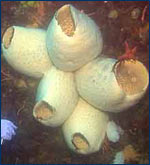
|
 |
 |

March 14, 2003
Antarctica's Colorful Garden
 |
Bakers says eating a bite of this sponge would
be "like eating fiberglass."
More Pictures |
Bill Baker sits unsteadily on the inflated edge of a bobbing Zodiac boat. He's
encased from top to bottom in a heavy black rubber suit, part of the protection
he needs for diving to the sea floor in these icy Antarctic waters. Baker is a
"natural products chemist" who studies the chemical composition of organisms.
He carries out two distinct, but related, branches of research. One area, chemical
ecology, is the study of how life uses chemicals in the never-ending battle between
predator and prey. The other area, bio-prospecting, is the search for useful chemicals,
mostly as possible new medical cures, hidden in the tissues of plants and animals.
I'm in the boat with Baker, a professor at the University of South Florida, on
assignment as a tender: a sort of modern-day, Antarctic butler helping the scientist
and his two assistants get their diving duds on. Above the surface the Antarctic
environment is bleak-all rocks and snow with dashes of green vegetation. But under
the surface, Baker says, Antarctic is a colorful "garden" with hundreds of species
of brilliantly colored sponges, corals and tunicates (of which the sea squirt
is one member). These exotic species completely carpet the ocean floor and the
walls of underwater canyons. Baker and his crew have come up with equally colorful
names to describe them, such as the "snot tunicate," the "turd tunicate" and the
"lollypop tunicate." My job as tender is to help divers suit up, to stand watch
on the surface while the researchers are below and to pull them into the boat
when they return. The divers each wear two pairs of long underwear, a fleece-lined
body suit and a waterproof rubber shell. After donning all these layers, they
are almost as helpless as beached whales and need assistance putting on their
rubber gloves and breathing gear.
Once he's completely dressed, and loaded with 160 pounds of gear, Baker slowly
leans back off the boat's edge and falls headfirst into the dark water. Before
long all three divers have disappeared below the gentle swell. A circle of bubbles
shows where they are.
There's not much to do while the crew is below other than enjoy the scenery and look for leopard seals. There are no known incidents of leopard seals attacking humans, but these animals are vicious, powerful hunters that could easily kill a diver. This season some of the local leopard seals have been very curious (or possibly very aggressive, its hard to say which) and have approached within several feet of Baker. "They could take us if they wanted to," says Baker. When tenders see a leopard seal they bang a piece of metal on an oxygen tank, both to warn the divers and to frighten the seals. At that point, says Baker, "the dive is over."
Baker and his team are below for less than an hour. They only carry about one
hour's worth of air, but it's the cold that limits the dive. Even with four layers
of clothing, an hour is just about as long as they can withstand water that's
only about 32 degrees Fahrenheit. The dive was a success. Kevin Peters, a graduate
student at the University of Alabama found "the catch of the day," a bright red
sea sponge about the size and shape of a veal cutlet.
Back at Palmer Station the samples are freeze-dried. Some will be processed further
here while others will be saved for later studies. The first stage of the laboratory
research is to determine if the harvested organisms are toxic to the chief seafloor
predator here, the starfish. Baker says organisms have many ways of ensuring their
survival. Sometimes they have protective shells (like turtles), sometimes they
grow quickly (like weeds) and sometimes they contain toxins (like poison ivy).
Few of the seabed animals in Antarctica have physical defenses like shells. Most
don't appear to survive by growing fast. So Baker expects many to use toxins for
defense. One way to find out if they do is by cutting them up and feed pieces
to a tank full of starfish. Samples that are refused by the star fish either don't
taste good or are poisonous.
The animals that appear to be toxic (or "have chemistry," as Baker puts it) may
contain medically useful compounds. Baker says about 60 percent of all drugs in
use today originated with plants or animals. He says after a decade of studying
Antarctic creatures he's convinced that these organisms are loaded with useful
compounds. Two chemicals isolated by other researchers from tunicates are currently
undergoing trials for use as anti-cancer drugs. Baker will spend the coming months
and years trying to purify and synthesize the compounds that make some of his
samples unpalatable to star fish.
Read the February 14th entry
Read the February 10th entry
Read the February 6th entry
Read the February 5th entry
Read the January 31st entry
Read the January 27th entry
Read the January 22nd entry
Read the January 17th entry
Read the January 14th entry
Read the January 13th entry
Read the January 9th entry
Read the December 29th entry
Read the December 23rd entry
|
|



